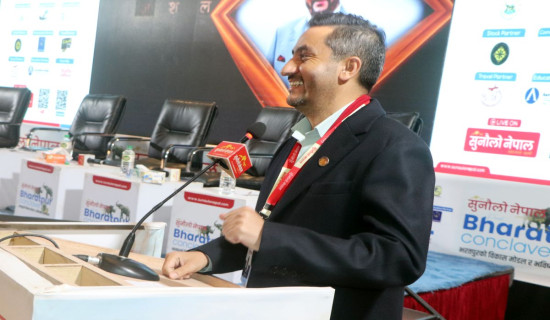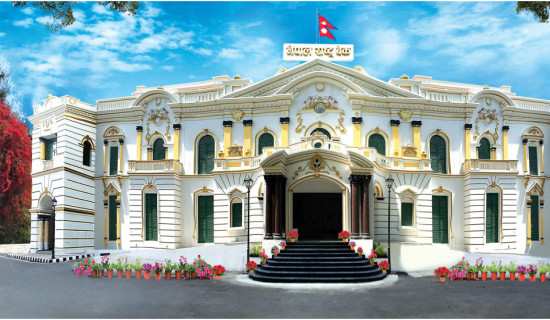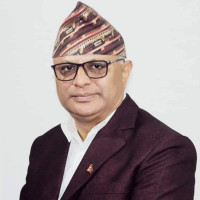- Friday, 2 January 2026
Conservation of sources stressed to address water scarcity problem
BY A STAFF REPORTER Kathmandu, Mar. 23: Water scarcity has emerged as a critical issue in Nepal which demands immedi-ate action. Amidst growing water scarcity, dif-ferent organisations in Nepal united together to generate awareness to con-serve water sources on Friday on the occasion of World Water Day.
The theme for this year’s World Wate Day was “Leveraging Water for Peace,” indicating the importance of water for maintaining peace around the world. The day was observed by letting everyone know how water can bring countries and communities together.From food security to public health, economic stability, and political influ-ence, the scarcity of water poses com-plex challenges, said former Minister Dr. Ganesh Shah. Sustainable management of water resources has become the princi-pal, particularly in the face of rising demand and the impacts of climate change, he added. In Nepal, just 25 per cent of people have access to healthy drinking water while 95 per cent have access only to basic facilities.
In the 15th five-year plan (2020/21- 2024/2025), the govern-ment aimed to provide basic drinking water to 99 per cent of people and qual-ity drinking water to 40 per cent but failed to meet the target.The National Planning Commission also aims to achieve a national goal of providing quality drinking water to 90 per cent of the population by 2030.According to former Shah, the rural areas were experiencing more water scarcity compared to the urban areas.
He attributes this scarcity to infrastruc-ture development, such as extensive road construction, which leads to the drying up of springs. More people in the rural areas are struggling to access water for their daily needs and irrigation purposes. “Lack of irrigation results in food scarcity in the rural areas prompting people to migrate to the urban areas in search of food availability,” he added.“The rise in urban migration is driv-ing up food imports in Nepal, primarily due to inadequate water supply. This trend is jeopardising food security in the country,” Dr. Shah added.The only viable option currently is to conserve rainwater, clean and preserve springs, and ponds, and ensure the cleanliness of rivers and other water sources, he said.
He also stressed the need for rainwa-ter harvesting. He said that rainwater harvesting not only contributes to direct con-sumption, household use, and use in agriculture, industry, and other sec-tors but also helps replenish water sources. He emphasised that rainwater collection and purification, along with the reuse of treated water, could sig-nificantly contribute to water source replenishment.Recently, the International Centre for Integrated Mountain Development (ICI-MOD) in collaboration with the Austra-lian Water Partnership (AWP) released three significant reports. These studies, spanning eight nations in the Hindu Kush Himalaya region, highlighted cli-mate change as a pressing factor neces-sitating collaboration across three vital river basins in Asia -- the Indus, the Ganga, and the Brahmaputra.
According to another research on “Dry-ing of Springs in the Himalayan Region of Nepal: Perspectives of Local Government Leaders on Causes, Consequences, and Conservation Efforts,” in the Himalayan region, the availability of water from nat-ural springs is declining, posing a signifi-cant threat to millions of people’s access to clean water and sanitation.Dr. Ngamindra Dahal, a climate change expert, stated that the majority of people in the Himalayas depend on spring water, and they are facing chal-lenges. He said, “It is better to identify local springs and assess how they are managed by local communities and authorities and make them aware of the uses of those available water sources.
”In his message on World Water Day, Dr. Pema Gyamtsho, Director General for ICIMOD said, an estimated 100 mil-lion people in the Hindu Kush Hima-layan region depend on springs to meet their drinking water, sanitation, live-stock rearing and irrigation needs. “If springs continue to dry at the same rate, this could lead to widespread water stress, displacement, and conflicts. We have worked with partners to prototype technolo-gies and approaches to revive drying springs and build autonomous water security.
We are now working to scale these approaches with support from donors, local govern-ments, and communities,” Gyamtsho said.As with river basin management, managing springs sustainably requires management of the ‘springsheds’ – going beyond managing only the sources (springs) to focus on the ‘recharge area’, through which water infiltrates and reaches the aquifers, where groundwa-ter is stored and emerges at the surface as a spring, he added.
















